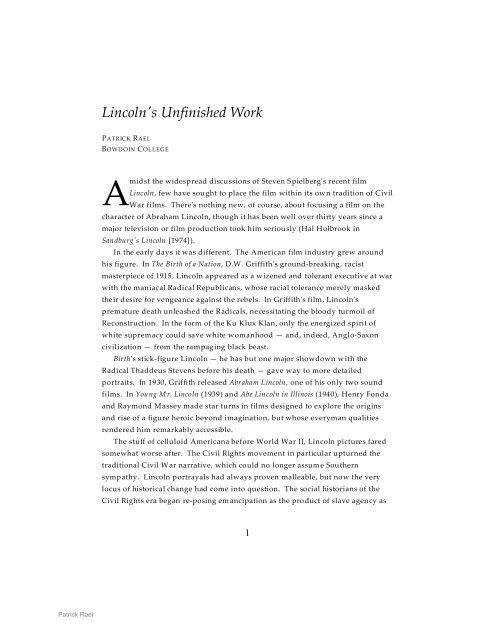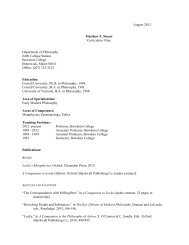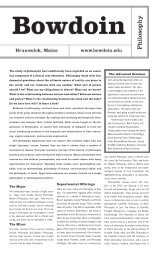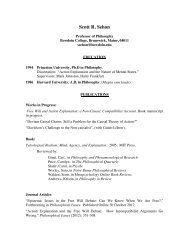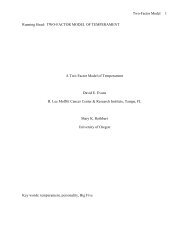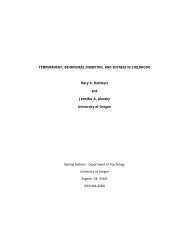Lincoln's Unfinished Work - Bowdoin College
Lincoln's Unfinished Work - Bowdoin College
Lincoln's Unfinished Work - Bowdoin College
Create successful ePaper yourself
Turn your PDF publications into a flip-book with our unique Google optimized e-Paper software.
<strong>Lincoln's</strong> <strong>Unfinished</strong> <strong>Work</strong><br />
PATRICK RAEL<br />
BOWDOIN COLLEGE<br />
Amidst the widespread discussions of Steven Spielberg's recent film<br />
Lincoln, few have sought to place the film within its own tradition of Civil<br />
War films. There's nothing new, of course, about focusing a film on the<br />
character of Abraham Lincoln, though it has been well over thirty years since a<br />
major television or film production took him seriously (Hal Holbrook in<br />
Sandburg's Lincoln [1974]).<br />
In the early days it was different. The American film industry grew around<br />
his figure. In The Birth of a Nation, D.W. Griffith's ground-breaking, racist<br />
masterpiece of 1915, Lincoln appeared as a wizened and tolerant executive at war<br />
with the maniacal Radical Republicans, whose racial tolerance merely masked<br />
their desire for vengeance against the rebels. In Griffith's film, <strong>Lincoln's</strong><br />
premature death unleashed the Radicals, necessitating the bloody turmoil of<br />
Reconstruction. In the form of the Ku Klux Klan, only the energized spirit of<br />
white supremacy could save white womanhood — and, indeed, Anglo-Saxon<br />
civilization — from the rampaging black beast.<br />
Birth's stick-figure Lincoln — he has but one major showdown with the<br />
Radical Thaddeus Stevens before his death — gave way to more detailed<br />
portraits. In 1930, Griffith released Abraham Lincoln, one of his only two sound<br />
films. In Young Mr. Lincoln (1939) and Abe Lincoln in Illinois (1940), Henry Fonda<br />
and Raymond Massey made star turns in films designed to explore the origins<br />
and rise of a figure heroic beyond imagination, but whose everyman qualities<br />
rendered him remarkably accessible.<br />
The stuff of celluloid Americana before World War II, Lincoln pictures fared<br />
somewhat worse after. The Civil Rights movement in particular upturned the<br />
traditional Civil War narrative, which could no longer assume Southern<br />
sympathy. Lincoln portrayals had always proven malleable, but now the very<br />
locus of historical change had come into question. The social historians of the<br />
Civil Rights era began re-posing emancipation as the product of slave agency as<br />
1<br />
Patrick Rael
Lincoln’s <strong>Unfinished</strong> <strong>Work</strong><br />
much as Union policy. The 1970s marked a brief moment of promise, in which<br />
popular film might adopt the new scholarship. Television projects such as The<br />
Autobiography of Miss Jane Pittman (1974) and Roots (1977), which both found<br />
critical success, focused on stories on the ground — of the lives of those who<br />
lived under and struggled against slavery.<br />
The cinematic impact of these early efforts proved abortive. The projects<br />
heralded no new era of popular historical film in which the oppressed would<br />
voice their own stories. As American political culture withdrew into the<br />
conservativism of the Reagan years, the cultural space for depicting social history<br />
on film diminished. In particular, major studios came to believe that films about<br />
black people's past could never find a major (read: white) audience.<br />
In 1989, Glory broke the logjam with a new formula. By focusing on war, the<br />
movie appealed to audience tastes for violence and period detail. And by<br />
seeking to balance the story of its black protagonists (who were fictional<br />
caricatures) with its white one (Robert Gould Shaw, the colonel who actually led<br />
the regiment), studios fabricated a cross-over film that might appeal to multiple<br />
audiences. Historians derided the film for privileging its "white" story over its<br />
black, for fictionalizing the stories of subjects on whom a goldmine of historical<br />
sources existed, for depicting masculine endeavor as the sole pathway to<br />
freedom, and for ending its story before the war was ever won. Yet it also earned<br />
critical and box-office renown.<br />
More significantly, it comported with other depictions of the black "freedom<br />
struggle" in film. Many of these concerned the Civil Rights Movement, which in<br />
the late 1980s was quickly passing from lived experience into historical memory.<br />
Films such as Mississippi Burning (1988), The Long Walk Home (1990), and Ghosts of<br />
Mississippi (1996) depicted African Americans' struggles against segregation and<br />
caste oppression. At the same time, a spate of films addressed the struggle<br />
against Apartheid in contemporary South Africa. Cry Freedom (1987), A Dry<br />
White Season, and The Power of One (1992) — all portrayed the black freedom<br />
struggle in terms remarkably reminiscent of the films set in America.<br />
Whether set in the Civil Rights South or South Africa, these films all sought to<br />
balance white and black stories. In each, though, the real drama derived from the<br />
struggles of white protagonists as they cope with the caste ostracism attending<br />
2<br />
Patrick Rael
Lincoln’s <strong>Unfinished</strong> <strong>Work</strong><br />
their conversion to the cause of black freedom. In A Dry White Season, when the<br />
white protagonist — a teacher who witnesses the violence of Apartheid — is<br />
fired, his wife admonishes him: “You have to choose your own people, or you<br />
have no people.” In The Long Walk Home, the protagonist Miriam, a middle-class<br />
white woman participating in the Montgomery Bus Boycott, suffers her<br />
husband's abandonment.<br />
Some of the freedom struggle films performed solidly at the box office, and a<br />
few garnered some critical acclaim. But none proved successful enough for the<br />
notoriously risk-averse Hollywood establishment. By the turn of the century, the<br />
American public had apparently had enough with racial sanctimony, white guilt,<br />
and boring history. Indeed, Civil War stories still made it to the screen; the Lost-<br />
Cause paean Gods and Generals (2003), could not have been made had not Glory<br />
made such ground safe — but gone was the sharp edge of racial politics and<br />
white agony. While race placed a minor role in Ang Lee's Ride with the Devil<br />
(1999) — the key black character plays a Confederate guerilla — the film<br />
adaptation of Cold Mountain (2003) was set so snugly in white Appalachia that<br />
the issue barely arose.<br />
The freedom struggle formula devolved. One bifurcated strand led toward<br />
"black" stories that appealed to a vague culturally nationalist sensibility: Spike<br />
Lee's Malcolm X (1992), John Singleton's Rosewood (1997), and Mario Van<br />
Peebles's Panther (1995). More rarely, it was preserved in stories that centered on<br />
white protagonists, such Michael Apted's Amazing Grace (2006), the story of Great<br />
Britain's great champion of slave trade abolition, William Wilberforce.<br />
Spielberg's earlier venture into the history of slavery, Amistad (1997), was of<br />
this ilk. The film retains vague hints of caste conversion, as in the figure of lead<br />
attorney Roger Baldwin, whom it depicts as a pragmatist driven to take up the<br />
cause of slave rebels in spite of himself, whereas the real Roger Baldwin<br />
represented the Amistad captives out of a deep and longstanding commitment to<br />
the plight of the less fortunate. Amistad also sought to tell "black" stories,<br />
whether of the slave rebel Cinque, or of Theodore Joadson, the fictional free<br />
African American who (as black characters do in Lincoln) serves as moral<br />
counter-weight to the political pragmatism impelling the primary action.<br />
3<br />
Patrick Rael
Lincoln’s <strong>Unfinished</strong> <strong>Work</strong><br />
Against these films, Lincoln occupies an important and curious place. With<br />
each passing year of cinematic neglect, <strong>Lincoln's</strong> cultural prestige has risen,<br />
making it all the more difficult to tackle him with due reverence. Taking on a<br />
topic of such gravitas is a high-risk, high-reward proposal, with success<br />
promising enormous prestige. Such was Spielberg's respect for his subject that<br />
on set he even abandoned his trademark civvies and baseball cap in favor of a<br />
suit and tie. In this sense, Lincoln clearly resembles — indeed, epitomizes —<br />
Spielberg's previous attempts at haute cinema: The Color Purple (1985), Schindler's<br />
List (1993), and Amistad.<br />
Yet for all of its pretense, Lincoln offsets its gamble by focusing on a<br />
remarkably thin slice of Civil War history. Unlike the great epics Birth of a Nation<br />
or Gone with the Wind (1939), it concerns itself with only a brief period — just four<br />
months, or five pages of Doris Kearns Goodwin's enormous Team of Rivals<br />
(Simon and Schuster, 2005), the inspiration for the film.<br />
In distilling the story of freedom into a tale of back-room politicizing and<br />
pressure-filled legislative maneuvers, Lincoln strips the Civil War epic of its most<br />
popular and potent narratives. It eschews Lost Cause mythology just as much as<br />
it evades caricatures of a brother’s war. Likewise absent is the common depiction<br />
in American films of politics as the hopeless preserve of the self-serving; here,<br />
<strong>Lincoln's</strong> mastery of the political process reifies noble ideas. Gone also is the<br />
freedom struggle film's motif of caste transformation. Spielberg's Lincoln has<br />
already been converted — not, albeit, to a full-blown commitment to racial<br />
equality, but to an attenuated commitment to the necessity of abolition. The film<br />
depicts the convert's work of enacting a platform we never see him struggle to<br />
adopt.<br />
The film's constricted chronology mirrors its constricted ideals. Lincoln<br />
succeeds, but only within the strict limits of its own moral universe. The struggle<br />
is not to enact a meaningful freedom for the millions recently freed, only to<br />
secure legal abolition. To be sure, this was far from nothing. But neither was it<br />
the full freedom promised by emancipation, enacted briefly by the Radical<br />
Republicans, and nullified by Redemption. Of that failure, which is surely an<br />
indispensable element of the Civil War narrative, Lincoln says nothing (more on<br />
which shortly).<br />
4<br />
Patrick Rael
Lincoln’s <strong>Unfinished</strong> <strong>Work</strong><br />
Lincoln thus doubly distinguishes itself from the pack: whereas the<br />
unreconstructed Civil War film tradition gestured toward sweeping tales that<br />
spanned from the antebellum period through Reconstruction, Lincoln concerns<br />
itself with a single measure and a few short months. And whereas the<br />
reconstructed Civil War film tradition concentrates on the local and often lowly,<br />
Lincoln sits confidently on its perch atop the halls of power.<br />
Lincoln confounds because of this combination of historical gravitas and<br />
narrow focus. The problem is not what the film does so much as what it doesn't<br />
do. Compressing the subject from freedom writ large to the Thirteenth<br />
Amendment compensates for the risky weight of <strong>Lincoln's</strong> subject. Strictly<br />
delimiting the story insulates the filmmakers from charges that they have missed<br />
something important. "Why did we not deal with X? Because we chose not to<br />
make that film."<br />
This move replicates Spielberg's earlier foray into the realms of nineteenthcentury<br />
antislavery, Amistad, the story of an 1839 slave revolt aboard a Cuban<br />
ship that wound up on New England shores. That film's bizarre elision of<br />
American slavery was made sensible only by the filmmakers' claim that they<br />
sought to tell an accurate story that adhered to a real history — just one that<br />
happened not to be set in the South. How else could one make a film about<br />
antebellum slavery that somehow says almost nothing about the American<br />
slavery? Instead, the film displaced responsibility for slavery onto the decrepit<br />
Old World regime of Spain. In Amistad, the very choice of subject predefined the<br />
parameters of what the film could tackle, in the process effectively side-stepping<br />
the cataclysmic reality of Southern slavery's impact on the entire American<br />
political system.<br />
Similarly, in Lincoln Spielberg lays claim to historical authenticity by defining<br />
his topic tightly — in this instance, the legislative minutiae surrounding a very<br />
selective slice of the story of slavery's ending in the United States. And as with<br />
Amistad, scholarly critics have been left gasping. The film clearly does not work<br />
well to illuminate the concerns of the present generation of scholarship on the<br />
Civil War, which focuses on the innumerable stories of emancipation that Lincoln<br />
decided not to tell.<br />
5<br />
Patrick Rael
Lincoln’s <strong>Unfinished</strong> <strong>Work</strong><br />
It is entirely fair to ask why Spielberg chose to make this film about slavery<br />
and not another. The challenge may appear presumptuous, but is it any less so<br />
than Hollywood filmmakers' claim to tell historical stories that reflect the most<br />
respectable scholarship? After all, Lincoln does not offer itself as a highly<br />
fictionalized variety of historical filmmaking on the order of, say, The Patriot or<br />
Gladiator; it pretends to something higher.<br />
Spielberg's choice of topic is not a trivial matter, for it speaks to the entire<br />
tradition's most glaring sin of omission. Though Lincoln addresses the end of<br />
slavery, it says nothing about what followed. Whereas Civil War films before<br />
World War II often coped with the aftermath of war by incorporating the<br />
predominate "Dunning" school of conservative Reconstruction historians, the<br />
post-war tradition has never assimilated new generations of scholarship on the<br />
period. Both Jane Pittman and Roots offered promising but stillborn possibilities.<br />
Since the genre's re-birth in 1989, only a very few films have even attempted<br />
to explore what followed the Civil War. Though set in Reconstruction, the<br />
critically-acclaimed film version of Toni Morrison's Beloved (1998) dealt more<br />
with the memory of slavery than with the pressing political concerns that shaped<br />
the post-Civil War South, while the major-studio release Sommersby (1993) used<br />
the post-war setting to re-enact the medieval story told in The Return of Martin<br />
Guerre (1982). Neither commented much on the harsh political realities required<br />
to make the emancipation depicted in Lincoln meaningful.<br />
Lincoln thus helps illustrate that the dominant motif of the modern Civil War<br />
film tradition is this failure to address the aftermath of slavery. What in epics<br />
like Birth of a Nation and Gone with the Wind had served as integral chapters in the<br />
Civil War story have been utterly neglected, despite that — or, more likely<br />
because — waves of scholarly revision and synthesis have completely overturned<br />
the old racist mythologies. Nothing better emblematizes this than <strong>Lincoln's</strong><br />
Radical Republicans. Personified by Thaddeus Stevens, they appear almost as<br />
Dunning-school archetypes, contemptuous of democracy while hypocritically<br />
relying on it for their power.<br />
This is an enormous shame. Not only is it inaccurate, it does nothing to help<br />
Americans come to grips with the failed promise of freedom that followed<br />
<strong>Lincoln's</strong> death. The destruction of slavery liberated four million people of<br />
6<br />
Patrick Rael
Lincoln’s <strong>Unfinished</strong> <strong>Work</strong><br />
African descent, but only because a devastating war demanded their<br />
emancipation. And while war settled some of the fundamental issues that<br />
started it, such as whether or not humans could be held as property, it did not<br />
resolve the meaning of freedom. Determining the fate of the millions liberated in<br />
the course of war meant determining whether or not the United States would be<br />
a nation that extended the blessings of liberty to all, or sanctioned a second-class<br />
citizenship at variance with its own national promises. This subject occupied the<br />
painful decade following <strong>Lincoln's</strong> death.<br />
It is an ignominious tale, but not because champions of black freedom acted<br />
vindictively and overturned the racial hierarchy. Rather, the victorious Union<br />
failed in its commitment to full freedom and meaningful liberty for African<br />
Americans, a subject on which Lincoln remained deeply ambivalent to his end.<br />
When the political going got tough, the white supremacy latent throughout<br />
American society re-emerged. It won the day, and what followed was a descent<br />
into the nation's most disgraceful and anti-democratic period of racial antipathy.<br />
In the era of Jim Crow, history moved backwards, away from inclusion and the<br />
triumph of liberty. It took another century to reverse gear and begin to deliver<br />
on the broken promises of Reconstruction.<br />
Lincoln is yet further evidence that this story is not one Hollywood seems<br />
much inclined to tell. But in an age wherein a person of African descent may be<br />
placed in <strong>Lincoln's</strong> office by an electorate whose right to vote remains contested,<br />
it may be well worth someone's effort.<br />
Patrick Rael is Associate Professor of History at <strong>Bowdoin</strong> <strong>College</strong>. He has written and taught on the<br />
history of the Civil War in film. His latest work is Eighty-Eight Years: The Long Death of Slavery in the<br />
United States (University of Georgia Press, forthcoming).<br />
CITE AS: Patrick Rael, “Lincoln’s <strong>Unfinished</strong> <strong>Work</strong>,”<br />
(December 11, 2012).<br />
7<br />
Patrick Rael


